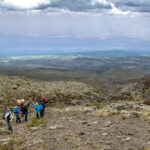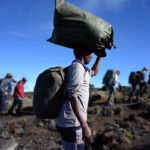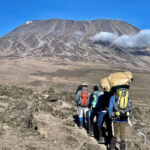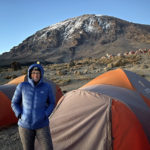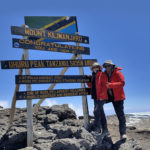
The fact that Thomson provides fresh meals throughout your entire Kilimanjaro trek, including fresh produce daily, comes as a surprise to many climbers. Few other companies make the effort to provide fresh, healthful food.
Once you realize all the behind the scenes work that goes into Thomson’s mountain gourmet food, though, you understand why it’s such a rarity.
On an average trek, over 800 pounds of food will be needed just to feed the trekkers. (Even more winds its way up the mountain for the support staff of dozens of porters and multiple guides!)
 Mountain cook Felicien carefully packs food and supplies at the Arusha office for an upcoming trek.
Mountain cook Felicien carefully packs food and supplies at the Arusha office for an upcoming trek.
 Mountain trail snacks are made from scratch in the Arusha offices. Josephina mixes dry ingredients for Zawadi energy bars, which will be pressed into trays and dehydrated (not baked) before cutting and packaging.
Mountain trail snacks are made from scratch in the Arusha offices. Josephina mixes dry ingredients for Zawadi energy bars, which will be pressed into trays and dehydrated (not baked) before cutting and packaging.
 Moses and the bread-mixing droid. This machine is a serious workhorse! During high season, it helps prepare enough dough for 50+ loaves of bread per day!
Moses and the bread-mixing droid. This machine is a serious workhorse! During high season, it helps prepare enough dough for 50+ loaves of bread per day!
At Thomson, we think it’s important that our trekkers eat the most nutritional, balanced diet possible. While some meals—such as lasagna, or the rich homemade stocks used in our soups—can be partially prepared at the Arusha offices (then packaged in eco-friendly recycled-foam coolers, transported up the mountain, and cooked by the camp chef), most meals must be fully prepared in camp.
That means resupplying important ingredients throughout the trek, in huge quantities. At least once during your trek, porters will resupply hundreds of pounds of fresh ingredients. These are carefully packed by type in coolers or lightweight baskets in order to make it safely up the mountain.
 A small portion of one of the detailed menu plans created for each trek. Gluten-free, vegetarian, and other specialized diets are taken into consideration.
A small portion of one of the detailed menu plans created for each trek. Gluten-free, vegetarian, and other specialized diets are taken into consideration.
Porters often travel with the supplies balanced on their heads, stabilized by a simple straw ring (a carrying method most have been perfecting since childhood). They can’t take the same trails as trekkers, however. They’d never catch up to the groups they’re feeding if they had to wind their way past trekkers who’d started their adventures in the days since Thomson’s departure!
 A Thomson porter carries a basket of food up the mountain on his head.
A Thomson porter carries a basket of food up the mountain on his head.
Instead, they take special ascent and descent routes that are many miles longer, but provide for a quicker, traffic-free trip up the mountain. Porters ascend thousands of vertical feet, drop off their precious cargo, then descend via the same winding routes, all in just 2-3 days! (In order to ensure their safety, Thomson always sends along a guide, and only lets the resupply team ascend and descend in full daylight.)
Other than a few items that would be impossible to prepare on Kilimanjaro’s slopes (like breads, cakes, or stock for soup), cooking happens in camp. Refreshing, healthful salads, rich soups that start with fresh vegetables cooked in high-quality olive oil (a rarity throughout Tanzania), or a gourmet filet steak dinner, wouldn’t be possible without the complex resupply system used by Thomson.
Thomson goes the extra mile—literally—to make sure you’re getting the delicious fuel your body needs to reach the summit!

